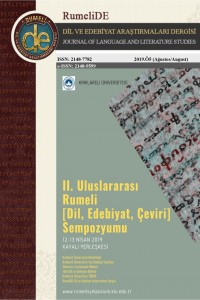Öz
In this study,
mythological aspects of the female body will be presented in relation to the
powerful female body image. It is well-known that in ancient Greek culture, mythology was considered a source of
power for male and female characters who were parts of mythological stories.
However, the female power, or the power of being a woman, are considered
significant for mythological female creativity, though its essence has always
been neglected by the male oriented world. This man-made obstacle over female
creativity has also been clarified in mythology, especially in mythological
representations of goddesses or witches. On this basis, this paper aims to
bring a close look to “the powerful women” as the mythological female heroines,
witches and representatives in ancient Greece, namely Demeter & Persephone,
The Amazons, Hecate, Medea and Medusa.
Anahtar Kelimeler
The female body Greek mythology goddesses witches the powerful women
Kaynakça
- Alban, GME. (2013). “Medusa as Female Eye or Icon in Atwood, Murdoch, Carter, and Plath”, Mosaic a Journal for the interdisciplinary study of literature, vol. 46, no. 4, December 2013, Canada: The University of Manitoba P., pp.163-182. Dörschel, FB. (2011). ““Female Identity”: Rewriting of Greek and Biblical Myths By Contemporary Women Writers”, Ph.D. Dissertation, Middle East Technical University. Gimbutas, M. (1999). The Living Goddesses, ed. Miriam Robbins Dexter, Berkeley and Los Angeles, California: University of California Press. Guerin, WL., et al. (1966). A Handbook of Critical Approaches to Literature, New York: Harper & Row, Publishers. Hamilton, E. (1999). Mythology: Timeless Tales of Gods and Heroes, New York: Grand Central Publishing. Hard, R. (1997). trans. Apollodorus: The Library of Greek Mythology, New York: Oxford University Press. Hulvey, SY. (2000). “Myths and Monsters: The Female Body as the Site for Political Agendas”, ed. Debra Walker King, Body Politics and The Fictional Double, Bloomington & Indianapolis: Indiana University Press, pp.71-88. Lies, BB. (1999). Earth’s Daughters: Stories of Women in Classical Mythology, Golden, Colorado: Fulcrum Publishing. Sivrioğlu, S. (2016). Fairies or Scaries From Tradition to Transformation: Challenging Grand Narratives of Fairy Tales, İstanbul: Kriter. Staley, G. (2006). “‘Beyond Glorious Ocean’: Feminism, Myth, and America”, Zajko, V. and Miriam Leonard ed. Laughing with Medusa: Classical Myth and Feminist Thought, New York: Oxford University Press. pp.209-230.
Öz
Bu çalışmada Kadın
Bedeni’nin mitolojik yönleri, güçlü kadın bedeni imgesi ile ilişkilendirilerek
sunulacaktır. Antik Yunan kültüründe mitolojinin, mitolojik hikayelerin birer
parçası olan erkek ve kadın karakterler için bir güç kaynağı olarak görüldüğü
iyi bir şekilde bilinmektedir. Ancak, önemi her ne kadar eril merkezli dünya
düzeninde ihmal edilse de; kadın gücünün ya da kadın olmanın verdiği gücün,
mitolojik kadın yaratıcılığı için önemli olduğu düşünülmektedir. Kadının
yaratıcılığı üzerinde erkeğin sebep olduğu bu engel, mitolojide, özellikle
tanrıça veya cadıların mitolojik tasvirlerinde detaylı bir biçimde ifade
edilmiştir. Bu bağlamda, bu çalışma, antik Yunan mitolojisinde kadın kahramanlara,
cadılara ve isim vermek gerekirse Demeter ve Persephone, Amazon Kadınları,
Hecate, Medea ve Medusa gibi mitolojik tasvirlere “güçlü kadın” gözüyle bir
bakış açısı getirecektir.
Anahtar Kelimeler
Kadın bedeni Yunan mitolojisi tanrıçalar cadılar güçlü kadınlar
Kaynakça
- Alban, GME. (2013). “Medusa as Female Eye or Icon in Atwood, Murdoch, Carter, and Plath”, Mosaic a Journal for the interdisciplinary study of literature, vol. 46, no. 4, December 2013, Canada: The University of Manitoba P., pp.163-182. Dörschel, FB. (2011). ““Female Identity”: Rewriting of Greek and Biblical Myths By Contemporary Women Writers”, Ph.D. Dissertation, Middle East Technical University. Gimbutas, M. (1999). The Living Goddesses, ed. Miriam Robbins Dexter, Berkeley and Los Angeles, California: University of California Press. Guerin, WL., et al. (1966). A Handbook of Critical Approaches to Literature, New York: Harper & Row, Publishers. Hamilton, E. (1999). Mythology: Timeless Tales of Gods and Heroes, New York: Grand Central Publishing. Hard, R. (1997). trans. Apollodorus: The Library of Greek Mythology, New York: Oxford University Press. Hulvey, SY. (2000). “Myths and Monsters: The Female Body as the Site for Political Agendas”, ed. Debra Walker King, Body Politics and The Fictional Double, Bloomington & Indianapolis: Indiana University Press, pp.71-88. Lies, BB. (1999). Earth’s Daughters: Stories of Women in Classical Mythology, Golden, Colorado: Fulcrum Publishing. Sivrioğlu, S. (2016). Fairies or Scaries From Tradition to Transformation: Challenging Grand Narratives of Fairy Tales, İstanbul: Kriter. Staley, G. (2006). “‘Beyond Glorious Ocean’: Feminism, Myth, and America”, Zajko, V. and Miriam Leonard ed. Laughing with Medusa: Classical Myth and Feminist Thought, New York: Oxford University Press. pp.209-230.
Ayrıntılar
| Birincil Dil | İngilizce |
|---|---|
| Konular | Türk Halk Bilimi |
| Bölüm | Türk dili, kültürü ve edebiyatı |
| Yazarlar | |
| Yayımlanma Tarihi | 21 Ağustos 2019 |
| Yayımlandığı Sayı | Yıl 2019 - RumeliDE 2019.Ö5 - II. Rumeli [Dil, Edebiyat, Çeviri] Sempozyumu Bildirileri |


